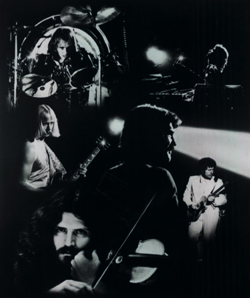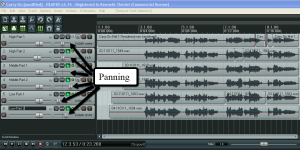Kansas “Carry On Wayward Son” Harmony: Step-By-Step
Okay, so here is how I recorded the introduction to Kansas’ “Carry on Wayward Son” with just me, myself and I (meaning it was just my voice singing all the parts).
First, take a listen to how it came out:

1. I opened my audio recording software, Reaper (see my post on Reaper here) on my computer.
2. I hit the “Record” button in Reaper and sang the melody (the high part:)) into the microphone, which was a Rode NT2-A. The mic was connected to the computer via an audio interface box like the Focusrite Scarlett 2i2.
3. When I finished singing that high part, I inserted another track in Reaper (ctrl-T) and sang that part again, giving me two tracks of my voice singing the same thing.
4. I inserted a 3rd & 4th track and repeated steps 1-2, but singing the middle vocal harmony part.
5. I inserted a 5th and 6th track and repeated steps 1-2, but singing the low vocal harmony part, “low” being extremely relative in this case;).
6. I edited each of the 6 tracks with my audio editing software, called Adobe Audition. Editing consisted of getting rid of “p-pops” and various other mouth-y noises, as well as making sure none of the notes were off-pitch.

7. Back in Reaper, I panned each track to a specific place in the “stereo spectrum,” which is a fancy way of saying “somewhere between your left ear and your right ear.” both high parts were in the center (right in front of you, between your eyes (actually they were 5% left and 5% right, but they’ll sound like they’re coming from right in front of you). The two middle parts were panned 100% left (“hard left”) and 100% right (yup, “hard right”) respectively. If listened to by themselves it would sound like one was coming from your left and the other coming from your right. The low parts were panned 53% left and right, respectively. These would sound like they were between the guy singing the high part and the guy singing the middle part, kinda like 6 guys were spread out in front of you on a stage. See the figure 1.
8. The next step was to make sure each part was the right volume, not too loud and not to quiet. That’s called mixing, and you do it by adjusting the volume slider on each track so all the sounds work and play well together.
9. Next I added a reverb effect to the “master” channel.
10. I rendered (called “mixing down” in the old days) the project audio down to one stereo file, which I saved as an mp3, and voila.
Look for lots of other home recording tips in the many articles posted here at Home Brew Audio. We’ve also got video tutorials and the eBook How To Create A Home Recording Studio.
Ta for now!
Ken
Free videos from “The Newbies Guide to Audio Recording Awesomeness”


Wow great job on the singing, mixing and everything else. Sounds exceptional!
Thanks Mike!
Thanks…curious. Reaper isn’t much money and you obviously praise it. I am wondering what you can do with it that you can not do using Audacity? I am mostly interested in spoken word stuff. Am curious about your opinion.
Thanks
Hi Brian. If you are only doing spoken word stuff, you just might be able to get by using Audacity. Though if you have any hiss or other noise you want to filter out, Audacity’s noise reduction isn’t very good in my opinion. In Reaper you can use a tool (comes with Reaper) called ReaFIR that filters out noise really well – better than some specialized noise reduction tools. Also, I think Reaper is much more intuitive and easy to use out-of-the-box. Audacity can be a bit confusing and clunky. But, if you know how to use Audacity, and don’t need to do much processing to the audio, then for spoken word stuff, Audacity may be just fine for you. I hope that helps.
Ken
ps-When you get into music recording, forget Audacity. That’s where Reaper does things that Audacity simply cannot do.
-K
Sounded awesome! Did you use sheet music for the harmony parts? I’m looking to find out if I can get some. Does this look right to you?
https://www.musicnotes.com/sheetmusic/mtdVPE.asp?ppn=MN0064307&ref=google
Thanks. That does look right. But no, I did not use sheet music. I’m pretty good at just hearing harmony parts. Always have been. It’s the reason, really, that I got started doing audio recording in fact.